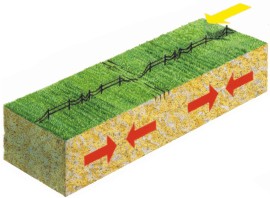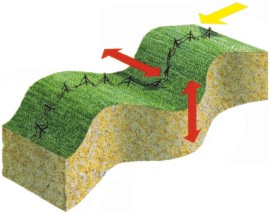Introduction
What is an Earthquake?
Why and Where?
Seismic Waves
How We Measure Them
Locating Earthquakes
Measuring the Size of an Earthquake
Intensity
The Structure of the Earth
The Biggest and the Deadliest
Earthquakes in the UK
Links to Seismology Information
Printable PDF of Earthquakes Booklet (2.7 MB) |
Two different types of seismic waves are generated by the sudden movement on a fault: P-waves and S-waves. A third type of seismic wave is generated by the interaction of the P- and S-waves with the surface and internal layers of the Earth. The speed of the waves depends on wave type and the properties of the rock; the denser the rock, the faster the waves travel. In the Earth’s crust P-waves travel at around 6-7 km/s, while S-waves travel at around 3.5-4 km/s. |
P-waves travel fastest. They consist of successive contractions and expansions, just like sound waves in air. The motion of the particles in the rocks that the waves travel through is parallel to the direction of the wave.

|
|
S-waves are slower than P-waves. They are transverse waves, which means that the particle motion is at right angles to the direction of travel. S-waves cannot travel through air or liquids.

|